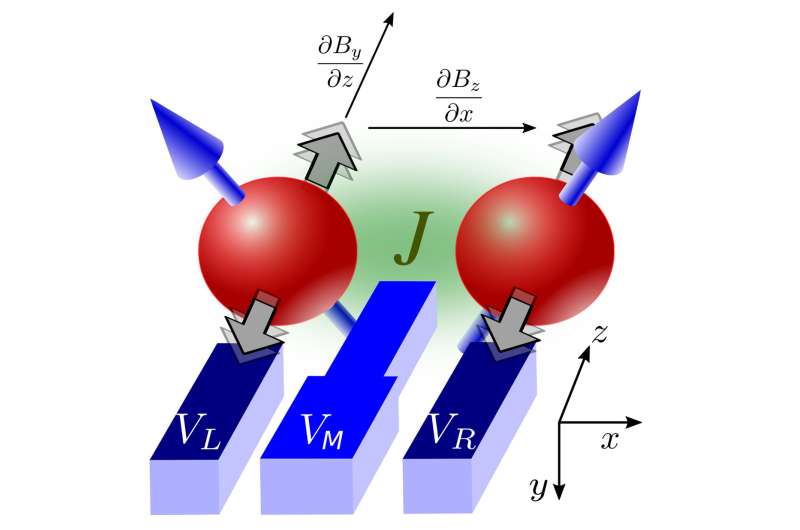The quantum gates of two silicon electrons. Two nano-electrodes (VL and VR) control the angular momentum of both electrons. A third nano-electrode (VM) coordinates the interaction of both electrons. Credit: University of Konstanz
Milestone on the path to the quantum computer: Scientists of the University of Konstanz, Princeton University, and the University of Maryland have developed a stable quantum gate for two-quantum bit systems made of silicon. The quantum gate is able to perform all necessary basic operations of the quantum computer. The electron spin of individual electrons in silicon is used as the basic storage unit ("quantum bits"). The research results were published ahead of print in Science on 7 December 2017.
It will take quite a few years until the production of commercial quantum computers. Quantum computers will be more efficient and will be able to solve problems impossible for current computers. However, the quantum computer reacts much more sensitively to external disturbances than a conventional machine. Consequently, a primary goal is to create stable "quantum gates"—the basic "building block" of the quantum computer. Scientists from the University of Konstanz, Princeton University and the University of Maryland now succeeded in creating stable quantum gates for two-quantum bit systems. Their quantum gate uses individual electrons in silicon to store the quantum bits, and they can precisely control and read out the interaction of two quantum bits. This way, the experiment includes all necessary basic operations of the quantum computer.
From electron to quantum bit
Just as a classical digital computer uses bits with the values of either zero or one as the basic units for all calculation processes, a quantum computer, uses quantum bits. The difference is that the quantum bit is not limited to two states (zero and one), but can exist in multiple states at once, and is therefore much more complex in its implementation than a simple digital system. Researchers have come up with several ideas for technically realizing a quantum bit, for example, using ions or superconducting systems. The researchers from Konstanz, Princeton and Maryland, however, use the electron spin, the intrinsic angular momentum of a single electron, as the basis of quantum bits. The electron's direction of rotation corresponds to the zero and one values of the digital bit, but in its exact quantum state, the electron is able to hold more information than just a simple zero or one.
A first achievement of the researchers was therefore to extract a single electron from the billions of atoms of a silicon piece. "That was an extraordinary achievement by our colleagues from Princeton," says physicist Professor Guido Burkard, who coordinated the theoretical research in Konstanz. The researchers used a combination of electromagnetic attraction and repulsion to separate a single electron from the electron bunch. The separated electrons are then lined up precisely and each is embedded in a kind of "hollow," where they are held in a floating state.
The next challenge was to develop a system to control the angular momentum of individual electrons. Konstanz physicists Guido Burkard and Maximilian Russ have developed the following method: a nano-electrode is applied to each electron. Using a magnetic field gradient, the physicists can create a position-dependent magnetic field with which to access the individual electrons, thereby enabling the researchers to control the angular momentum of the electrons. This way, they have created stable one-quantum-bit systems to store and read out information in the form of electron spins.
The step towards the two-quantum bit system
One quantum bit, however, is not enough to generate the basic switching system of a quantum computer. To do so, two quantum bits are required. The crucial step the Konstanz researchers took towards the two-quantum bit system was to link the states of two electrons. Such a link makes it possible to construct basal switching systems with which all basic operations of the quantum computer can be performed. For example, the system can be programmed in such a way that an electron rotates only when its adjacent electron has a spin in a predetermined direction.
This meant that the researchers from Konstanz had to create a stable system to link the spins of two individual electrons. "That was the most important and difficult part of our work," says Guido Burkard, who designed and planned the method together with team member Maximilian Russ. They developed a switching system that coordinates the angular momentum of two electrons in inter-dependence. An additional nano-electrode is placed between the two "hollows" in which the silicon electrons are floating. This electrode controls the coupling between the two electron spins. With this method, the physicists have realized a stable and functional basic processing unit of a quantum computer. Fidelities for single quantum bits are above 99 percent, and about 80 percent for two interacting quantum bits—significantly more stable and more accurate than in previous attempts.
Silicon—a "silent material"
The base material of the quantum gate is silicon. "A magnetically very silent material with only a low number of own nuclear spins," Guido Burkard says, summarizing the advantages of silicon. It is important that the atomic nuclei of the chosen material do not have too many spins, that is, intrinsic angular momentum, which could interfere with the quantum bits. Silicon, with around five percent, has an extremely low spin activity of its atomic nuclei and is therefore a particularly suitable material. Another advantage: Silicon is the standard material of semiconductor technology and accordingly well researched. The scientists can therefore benefit from many years of experience with the material.
More information: D. M. Zajac, A. J. Sigillito, M. Russ, F. Borjans, J. M. Taylor, G. Burkard, J. R. Petta, Quantum CNOT Gate for Spins in Silicon, Science 07 December 2017. DOI: 10.1126/science.aap5965 , On Arxiv: arxiv.org/abs/1708.03530
Provided by University of Konstanz























